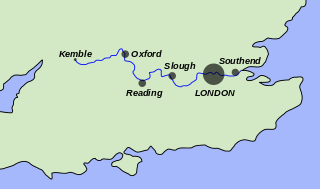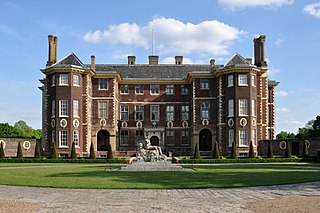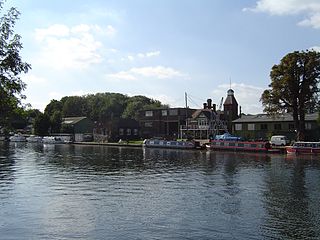Related Research Articles

The River Thames, known alternatively in parts as the River Isis, is a river that flows through southern England including London. At 215 miles (346 km), it is the longest river entirely in England and the second-longest in the United Kingdom, after the River Severn.
Richmond is a town in south-west London, 8.2 miles (13.2 km) west-southwest of Charing Cross. It is on a meander of the River Thames, with many parks and open spaces, including Richmond Park, and many protected conservation areas, which include much of Richmond Hill. A specific Act of Parliament protects the scenic view of the River Thames from Richmond.

Thames Television, commonly simplified to just Thames, was a franchise holder for a region of the British ITV television network serving London and surrounding areas from 30 July 1968 until the night of 31 December 1992. Thames Television broadcast from 9:25 Monday morning to 5:15 Friday afternoon at which time it would hand over to London Weekend Television (LWT).

The Battle of the Thames, also known as the Battle of Moraviantown, was an American victory in the War of 1812 against Tecumseh's Confederacy and their British allies. It took place on October 5, 1813, in Upper Canada, near Chatham. The British lost control of Southwestern Ontario as a result of the battle; Tecumseh was killed, and his confederacy largely fell apart.
Thames is a town at the southwestern end of the Coromandel Peninsula in New Zealand's North Island. It is located on the Firth of Thames close to the mouth of the Waihou River. The town is the seat of the Thames-Coromandel District Council. The Māori iwi are Ngāti Maru, who are descendants of Marutuahu's son Te Ngako. Ngāti Maru is part of the Ngati Marutuahu confederation of tribes or better known as Hauraki Iwi.

Goring-on-Thames is a village and civil parish on the River Thames in South Oxfordshire, England, about 5+1⁄2 miles south of Wallingford and eight miles northwest of Reading. It had a population of 3,187 in the 2011 census, put at 3,335 in 2019. Goring & Streatley railway station is on the main Oxford–London line. Most land is farmland, with woodland on the Goring Gap outcrop of the Chiltern Hills. Its riverside plain encloses the residential area, including a high street with shops, pubs and restaurants. Nearby are the village churches – one dedicated to St Thomas Becket has a nave built within 50 years of the saint's death, in the early 13th century, along with a later bell tower. Goring faces the smaller Streatley across the Thames. The two are linked by Goring and Streatley Bridge.

Thames House is an office building in Millbank, London, on the north bank of the River Thames adjacent to Lambeth Bridge. Originally used as offices by Imperial Chemical Industries (ICI), it has served as the headquarters of the United Kingdom's internal Security Service since December 1994. It also served as the London headquarters of the Northern Ireland Office (NIO) until March 2013.

The Nore is a long bank of sand and silt running along the south-centre of the final narrowing of the Thames Estuary, England. Its south-west is the very narrow Nore Sand. Just short of the Nore's easternmost point where it fades into the channels it has a notable point once marked by a lightship on the line where the estuary of the Thames nominally becomes the North Sea. A lit buoy today stands on this often map-marked divisor: between Havengore Creek in east Essex and Warden Point on the Isle of Sheppey in Kent.

Ham is a suburban district in Richmond, south-west London. It has meadows adjoining the River Thames where the Thames Path National Trail also runs. Most of Ham is in the London Borough of Richmond upon Thames and, chiefly, within the ward of Ham, Petersham and Richmond Riverside; the rest is in the Royal Borough of Kingston upon Thames. The district has modest convenience shops and amenities, including a petrol station and several pubs, but its commerce is subsidiary to the nearby regional-level economic centre of Kingston upon Thames.

The Thames Rowing Club (TRC) is a rowing club based on the tidal Thames as it flows through the western suburbs of London. The TRC clubhouse stands on Putney Embankment. The club was founded in 1860.

The River class, or Thames class, were a class of submarines built for the Royal Navy. Operating during the Second World War, the three boats of the class comprised Thames, Severn and Clyde. All the submarines were named after rivers in the United Kingdom. One was lost during the war and the rest taken out of service following it.

Platt's Eyot or Platt's Ait is an island on the River Thames at Hampton, in the London Borough of Richmond upon Thames, England, on the reach between Molesey Lock and Sunbury Lock.

Thames Valley Traction Company Limited was a major bus company operating services to and from Reading, Bracknell, Maidenhead, Newbury, High Wycombe and Oxford and surrounding areas for 52 years in the 20th century. For many years it ran the "Reading A" and "Reading B" limited-stop services between London's Victoria Coach Station and Reading via two differing sets of intermediate stops.

Teddington is a suburb in south-west London in the London Borough of Richmond upon Thames. In 2021, Teddington was named as the best place to live in London by The Sunday Times. Historically in Middlesex, Teddington is situated on a long meander of the Thames between Hampton Wick and Strawberry Hill, Twickenham. Mostly residential, it stretches from the river to Bushy Park with a long high street of shops, restaurants and pubs. There is a suspension bridge over the lowest non-tidal lock on the Thames, Teddington Lock. At Teddington's centre is a mid-rise urban development, containing offices and apartments.

SB Centaur is a wooden Thames sailing barge, built in Harwich, Essex, England in 1895. She was used to carry various cargoes, mainly grain, for the next 60 years. During the First World War she carried food and coal to the French Channel ports. During the Second World War Centaur was damaged when sailing to assist with the Dunkirk Evacuation. She did war work for the duration of the conflict.

The Ena is a wooden Thames sailing barge constructed in Harwich in 1906 that is resting on the flats adjacent to Stargate Marina in Hoo, Kent. She is a notable Dunkirk little ship reputed to have rescued 100 men.

Kingston upon Thames War Memorial, in the Memorial Garden on Union Street, Kingston upon Thames, London, commemorates the men of the town who died in the First World War. After 1945, the memorial was updated to recognise casualties from the Second World War. The memorial was commissioned by the town council and was designed by the British sculptor Richard Reginald Goulden. The memorial includes a bronze statue of a nude warrior, carrying a flaming cross and wielding a sword with which he defends two children from a serpent, erected on a granite plinth, with bronze plaques listing the names of the dead. Goulden designed a number of such allegorical memorials, including others at Crompton, Greater Manchester, and Redhill, Surrey. The Kingston memorial was designated a Grade II listed structure in 1983. This was revised upwards in 2016 to Grade II*, denoting a building or structure of particular importance.
References
- ↑ Pawle, Gerald (1957). The Secret War 1939-45. p. 188.